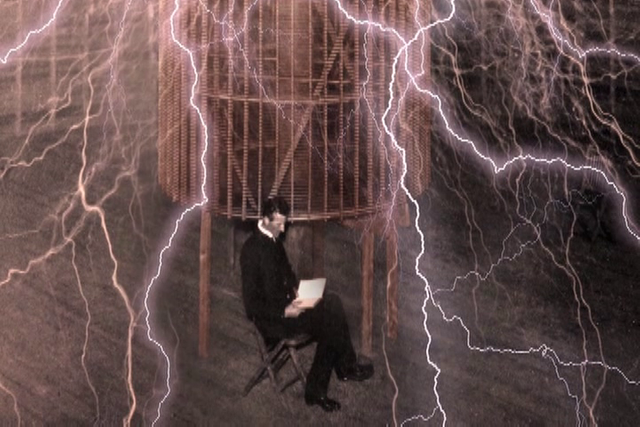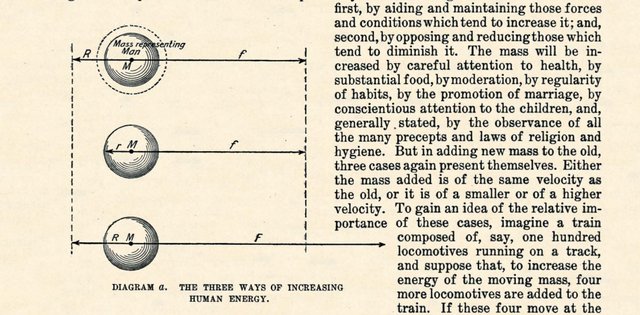Reading Nikola Tesla – part 2: What is electricity?
Here we are in 2018, over a hundred years later speculating about what could have been Nikola Tesla’s secret. I then think to myself: if only I could show you what I read, you would understand that there is no secret. When I read his articles and patents from 1900 onward, what I see is a man desperately trying to get his views across. He tries again and again in many different ways, but no-one seems to see what I see.

It is my sincere wish that one day people will read Tesla’s articles and really understand what he is saying.
So… Let me take you by the hand an walk you through his most famous article: “The Problem of Increasing Human Energy”, published in Century Illustrated Magazine of June 1900.
In this second part we take a look at how Tesla viewed electricity, we continue in the main article where we left off.
Though we may never be able to comprehend human life, we know certainly that it is a movement, of whatever nature it be. The existence of movement unavoidably implies a body which is being moved and a force which is moving it. Hence, wherever there is life, there is a mass moved by a force. All mass possesses inertia, all force tends to persist. Owing to this universal property and condition, a body, be it at rest or in motion, tends to remain in the same state, and a force, manifesting itself anywhere and through whatever cause, produces an equivalent opposing force, and as an absolute necessity of this it follows that every movement in nature must be rhythmical. Long ago this simple truth was clearly pointed out by Herbert Spencer, who arrived at it through a somewhat different process of reasoning. It is borne out in everything we perceive—in the movement of a planet, in the surging and ebbing of the tide, in the reverberations of the air, the swinging of a pendulum, the oscillations of an electric current, and in the infinitely varied phenomena of organic life. Does not the whole of human life attest to it? Birth, growth, old age, and death of an individual, family, race, or nation, what is it all but a rhythm? All life-manifestation, then, even in its most intricate form, as exemplified in man, however involved and inscrutable, is only a movement, to which the same general laws of movement which govern throughout the physical universe must be applicable.
A parallel is drawn here between humanity and electricity. What he says about humanity shows how he thinks about electricity; we know for certain that it is a movement, thus there must be a body being moved by a force. This body must possess inertia. A force acting on a body, creates motion, this motion is met with a counter-force and thus the resulting motion must be rhythmical. And the same universal law must be applicable.
This is a recurring theme when reading Tesla’s work; Tesla firmly believes in universal laws. Like, for instance, when he discovered that electrical effects are caused by a gaseous medium, he immediately concludes that all the laws that govern the behaviour of gasses must be applicable.
When we speak of man, we have a conception of humanity as a whole, and before applying scientific methods to, the investigation of his movement we must accept this as a physical fact. But can anyone doubt to-day that all the millions of individuals and all the innumerable types and characters constitute an entity, a unit? Though free to think and act, we are held together, like the stars in the firmament, with ties inseparable.
These ties cannot be seen, but we can feel them. I cut myself in the finger, and it pains me: this finger is a part of me. I see a friend hurt, and it hurts me, too: my friend and I are one. And now I see stricken down an enemy, a lump of matter which, of all the lumps of matter in the universe, I care least for, and it still grieves me. Does this not prove that each of us is only part of a whole?
I believe Tesla wants to convey the idea that an electric current or static charge acts as a unit but consists of a multitude of interchangeable particles that are in some way tied together. Now we immediately think of electrons, but that is not what Tesla is talking about for two reasons.
- One, Tesla does not believe in two electricities (positive and negative). They must both be the result of one and the same medium. An electron is at best half the particle that makes up electricity, the other half must be a positive counter-part.
- Two, Tesla’s axiom that says there is no energy in matter except that absorbed from the medium. So an electron -being matter- receives its electrical properties from the area around it. We should change the way we think about electricity. It is not charges creating fields, it is much more like fields creating charges.
For ages this idea has been proclaimed in the consummately wise teachings of religion, probably not alone as a means of insuring peace and harmony among men, but as a deeply founded truth. The Buddhist expresses it in one way, the Christian in another, but both say the same: We are all one.
Metaphysical proofs are, however, not the only ones which we are able to bring forth in support of this idea. Science, too, recognizes this connectedness of separate individuals, though not quite in the same sense as it admits that the suns, planets, and moons of a constellation are one body, and there can be no doubt that it will be experimentally confirmed in times to come, when our means and methods for investigating psychical and other states and phenomena shall have been brought to great perfection. Still more: this one human being lives on and on. The individual is ephemeral, races and nations come and pass away, but man remains.
Therein lies the profound difference between the individual and the whole. Therein, too, is to be found the partial explanation of many of those marvellous phenomena of heredity which are the result of countless centuries of feeble but persistent influence.
Here Tesla stresses the fact that the particles that create electrical effects are interchangeable, and most likely are continuously replaced.
Conceive, then, man as a mass urged on by a force. Though this movement is not of a translatory character, implying change of place, yet the general laws of mechanical movement are applicable to it, and the energy associated with this mass can be measured, in accordance with well-known principles, by half the product of the mass with the square of a certain velocity. So, for instance, a cannon-ball which is at rest possesses a certain amount of energy in the form of heat, which we measure in a similar way. We imagine the ball to consist of innumerable minute particles, called atoms or molecules, which vibrate or whirl around one another. We determine their masses and velocities, and from them the energy of each of these minute systems, and adding them all together, we get an idea of the total heat-energy contained in the ball, which is only seemingly at rest. In this purely theoretical estimate this energy may then be calculated by multiplying half of the total mass—that is half of the sum of all the small masses—with the square of a velocity which is determined from the velocities of the separate particles. In like manner we may conceive of human energy being measured by half the human mass multiplied with the square of the velocity which we are not yet able to compute. But our deficiency in this knowledge will not vitiate the truth of the deductions I shall draw, which rest on the firm basis that the same laws of mass and force govern throughout nature.
Here is a first hint that Tesla wants to include the concept of temperature when dealing with electricity. Think of an average kinetic energy of the constituting particles, these particles being the “atoms” of what he calls “the medium”. Later in this article there will be much more focus on this aspect, as this is the primary means of drawing power from “the medium”.
Man, however, is not an ordinary mass, consisting of spinning atoms and molecules, and containing merely heat-energy. He is a mass possessed of certain higher qualities by reason of the creative principle of life with which he is endowed. His mass, as the water in an ocean wave, is being continuously exchanged, new taking the place of the old.
Here Tesla again stresses the fact that the particles that create electrical effects are interchangeable and in fact continuously being exchanged.
Not only this, but he grows propagates, and dies, thus altering his mass independently, both in bulk and density. What is most wonderful of all, he is capable of increasing or diminishing his velocity of movement by the mysterious power he possesses by appropriating more or less energy from other substance, and turning it into motive energy. But in any given moment we may ignore these slow changes and assume that human energy is measured by half the product of man's mass with the square of a certain hypothetical velocity. However we may compute this velocity, and whatever we may take as the standard of its measure, we must, in harmony with this conception, come to the conclusion that the great problem of science is, and always will be, to increase the energy thus defined. Many years ago, stimulated by the perusal of that deeply interesting work, Draper's "History of the Intellectual Development of Europe," depicting so vividly human movement, I recognized that to solve this eternal problem must ever be the chief task of the man of science. Some results of my own efforts to this end I shall endeavour briefly to describe here.
Here we have a clear hint at his axiom, again; matter receiving its energy from “the medium”.
One should read this part (the entire part covered in this post) a number of times to create a picture in your mind of how it works.

Let, then, in diagram a, M represent the mass of man. This mass is impelled in one direction by a force f, which is resisted by another partly frictional and partly negative force R, acting in a direction exactly opposite, and retarding the movement of the mass. Such an antagonistic force is present in every movement and must be taken into consideration. The difference between these two forces is the effective force which imparts a velocity V to the mass M in the direction of the arrow on the line representing the force f. In accordance with the preceding, the human energy will then be given by the product ½ MV² = ½ MV x V, in which M is the total mass of man in the ordinary interpretation of the term "mass," and V is a certain hypothetical velocity, which, in the present state of science, we are unable exactly to define and determine. To increase the human energy is, therefore, equivalent to increasing this product, and there are, as will readily be seen, only three ways possible to attain this result, which are illustrated in the above diagram. The first way shown in the top figure, is to increase the mass (as indicated by the dotted circle), leaving the two opposing forces the same. The second way is to reduce the retarding force R to a smaller value r, leaving the mass and the impelling force the same, as diagrammatically shown in the middle figure. The third way, which is illustrated in the last figure, is to increase the impelling force f to a higher value F, while the mass and the retarding force R remain unaltered. Evidently fixed limits exist as regards increase of mass and reduction of retarding force, but the impelling force can be increased indefinitely. Each of these three possible solutions presents a different aspect of the main problem of increasing human energy, which is thus divided into three distinct problems, to be successively considered.
As I said in part 1 this sounds very abstract, not at all what you’d expect to hear from Tesla… if taken literally. When you consider drawing the parallel between this and electricity then it suddenly becomes very practical. To increase electrical energy we either increase the mass (charge or current), reduce all retarding forces (such as resistance) or increase the propelling force (voltage).
You will probably still have some doubts about this interpretation but it will become much more obvious at several points in this article. And when you read all of his work you will find that Tesla developed this way of communication after 1895 when his laboratory burnt down.
This article is the most intricate but also the most informative.
MUCH more to come….!
Tesla is a hero, I find his work to be interesting but also quite hard to grasp and comprehend for me from his papers/writings (of which there are A LOT!). Thank you for your interpretation here, it gets me closer to that.
Wonderful stuff, Thank you! :)
😄😇😄

Tesla's article is really great @mage00000 reading this article my life is getting excited, thanks a lot for the post
It would be nice to have Geoffrey Haselhurst http://spaceandmotion.com/ involved in your project.
I think Geoffrey is more interested in developing his own theory than in finding out what was Tesla's theory.
(I may be wrong, but that is the impression I get)
I want to read more of it...I had also posted one on Tesla long ago. I dint read these things
I have suggest this article for the next @steemstem distilled.
Thanks! :)
This thing is overwhelming. I read the problem of increasing human energy multiple times, and I admit having found something strange about it. But man, this is the real deal, you got it. Man you got it.